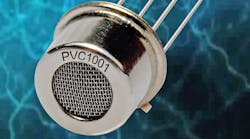Much of the Internet of Things (IoT) is mobile, and compact sensors play a key role in delivering status information for these connected devices. They range from tiny microelectromechanical-systems (MEMS) accelerometers to high-resolution cameras to time-of-flight (ToF) 3D imaging (see “Time-Of-Flight 3D Coming To A Device Near You”). These devices are common fare on smartphones and tablets.
This file type includes high resolution graphics and schematics when applicable.
Sensors often determine information indirectly through measurable changes that are affected by the data desired. For example, Posifa Microsystems’ PVC 1000 MEMS vacuum sensor (see the figure) is designed to measure pressure (see “MEMS Vacuum Sensors Offer Ultra Low Power Consumption”). It does so by looking at minute changes in resistance to a heated element—a thin-film, platinum resistor on a thermal insulating membrane. The membrane is suspended over a 25-μm-deep micromachined cavity. The bottom surface runs parallel to the membrane to ensure precision measurement of heat transfer. The volume of gas within the cavity is minuscule, allowing the sensor to have a fast response time (under 5 ms) while using little power (under 5 mW). It can measure from 10 millitorr to 30 torr. The sensor suits applications such as leak detection, vacuum packing systems, and portable digital vacuum gauges.
Crucial to today’s myriad sensors is sensor-fusion technology. It can integrate information from a set of disparate devices (see “Q&A: Freescale’s Ian Chen Discusses Sensor Fusion”). As a result, sensor-fusion platforms are able to provide virtual sensors (see “Understanding Virtual Sensors: From Sensor Fusion To Context-Aware Applications”) based on information derived from different but related sensors.
For example, accelerometers and gyroscopes are different devices, but both will provide useful contextual information. In some instances, the power requirements for accelerometers are lower than gyroscopes. For mobile applications that need to minimize power consumption, it would be useful to use only the accelerometer whenever possible. It’s possible to extrapolate gyro information from an accelerometer, although the data will not be as accurate as that from a gyroscope sensor. This may be sufficient for many applications. Likewise, the startup time for the gyro may be slower than the accelerometer. Therefore, using the accelerometer approximation during the interim would be effective, because the application would have available data.
Contextual virtual sensors can also simplify application development. An application might like to know if its device is being carried and how it might be transported. For example, with the proper sensors, it’s possible to determine whether a device is in a moving car, train, or elevator. Similarly, they could indicate that a device is in a pocket or on a table.
On another front, sensor and microcontroller integration can help simplify system design. The Kionix KX23H combines a 3-axis accelerometer with a Cortex-M0 microcontroller in a 3- by 3- by 0.9-mm package (see “Sensor Hub Combines 3-Axis Accelerometer And Cortex-M0 MCU”). The on-chip software could let a host processor know the movements experienced by a device, such as walking or riding in a train. The hub can also process inputs from external devices like gyroscopes, magnetometers, and pressure sensors.
This file type includes high resolution graphics and schematics when applicable.
These types of sensor hubs are ideal for mobile devices that enable the host processor to power down to minimize power consumption. However, it only starts when a significant event takes place.


